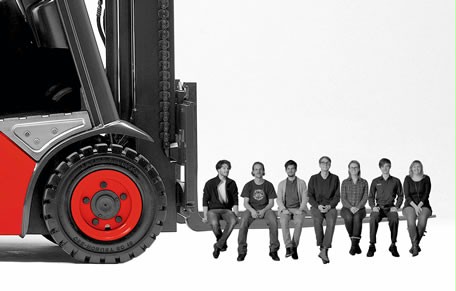 A group of Technical University of Munich students has designed a forklift workstation to meet society's changing needs. |
Seven students from the Technical University of Munich's masters program in industrial design have designed a forklift workstation to meet the needs of an ageing workforce.
For one semester, the students worked with Linde Material Handling to develop concepts for an ideal forklift workstation, using a Linde E20 electric forklift as the basis for their design.
As a starting point, the students visited the Munich Wholesale Market to watch forklift drivers in action. They noticed that, although the forklifts rarely stayed put for long, drivers sat in the cabs for prolonged periods without moving much.
Fritz Frenkler, a professor in the university's Department of Industrial Design, says: "Sitting for long periods is not good for the back. In addition, it becomes more difficult to turn around as you get older, because your body starts to stiffen up."
The students realised they lived in an ageing society where more people were working past the age of 60 and wanted to create a work environment that met changing physical requirements.
The students based their proposal on structural conditions and requirements of the 2T capacity Linde E20 electric forklift.
Replacing lead batteries with a lithium-ion battery provides more room and leads to new design options, such as a very low entry point into the forklift, allowing drivers to get in and out safely. The lithium-ion batteries' lower weight is offset by weights attached to the underbody.
A rotary-seated workstation, which can be converted into a standing workstation as required using a handle, allows drivers to adopt different positions and prevents individual body areas being put under strain.
To motivate forklift drivers, and improve how information was being processed, the students worked on additional concepts, including drivers being informed about a forklift's battery charge status from the truck exterior. Uusers also received individual electronic keys, called "TaLindesmans".
The keys store personal data, like preferred font sizes for the display or seating positions in the forklift. When a driver gets into a forklift, the system identifies the key and automatically adopts settings stored on the key.
The keys are in contact with each another, so they vibrate and beep to alert drivers when other forklifts approach.
The forklifts' display screens give drivers vital information, like vehicle wheel positions, lift mast tilts or fork arm positions. A touch screen allows drivers to communicate with colleagues.
The students are aware their concept involves preliminary results that require further investigation, tests and developments.
However, Linde's management team is broadly positive about their ideas.
Linde's head of communication and branding, Manfred Höhn, says: "Thanks to this study, we have obtained valuable information about the potential for the future development of forklifts."